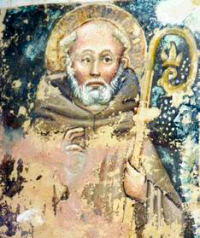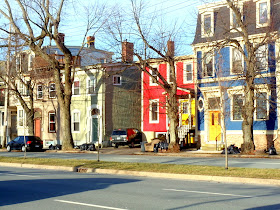Saint Sylvestre eut Rome pour patrie. Quand il fut en âge de disposer de sa fortune, il se plaisait à donner l'hospitalité aux chrétiens étrangers qui passaient à Rome; il les menait à sa demeure, lavait leurs pieds, leur servait à manger, enfin leur donnait, au nom de Jésus-Christ, tous les soins de la plus sincère charité.
Il vint, un jour, à Rome, un illustre confesseur de la foi, nommé Timothée d'Antioche. Personne n'osait le recevoir; Sylvestre s'en fit un honneur, et, pendant un an, Timothée prêchant Jésus-Christ avec un zèle incroyable, recevait chez lui la plus généreuse hospitalité. Cet homme héroïque ayant conquis la palme du martyre, Sylvestre déroba ses précieux restes et les ensevelit à la faveur de la nuit. Mais lui-même fut bientôt traduit devant le tribunal du préfet, comme recélant les trésors du martyr: "Timothée, répondit-il, ne m'a laissé que l'héritage de sa foi et de son courage."
Le préfet le menaça de la mort et le fit jeter en prison; mais Sylvestre, en le quittant, lui dit: "Insensé, c'est toi-même qui, cette nuit, vas rendre compte à Dieu." Le persécuteur avala une arête de poisson et mourut, en effet, dans la nuit. La crainte des châtiments célestes adoucit les bourreaux et l'héroïque jeune homme fut rendu à la liberté. Cette belle conduite de Sylvestre le fit appeler au diaconat par le Pape saint Melchiade, dont il devait être l'éminent successeur.
Son long pontificat de vingt et un ans, célèbre à divers titres, l'est surtout par le concile de Nicée, le Baptême de Constantin et le triomphe de l'Église. Le Baptême de Constantin est reporté à une époque plus tardive par de nombreux auteurs; mais des témoignages non moins nombreux et non moins sérieux placent le Baptême de ce grand empereur sous le règne de saint Sylvestre, et le Bréviaire romain confirme cette opinion.
Constantin, encore païen et peu favorable aux chrétiens, dont il ignorait complètement la doctrine, fut atteint d'une sorte de lèpre qui lui couvrit tout le corps. Une nuit, saint Pierre et saint Paul, éclatants de lumière, lui apparurent et lui ordonnèrent d'appeler le Pape Sylvestre, qui le guérirait en lui donnant le Baptême. Le Pape, en effet, instruisit le royal néophyte et le baptisa. Le règne social de Jésus-Christ commençait; la conversion de Constantin allait avoir pour heureuse conséquence celle de l'univers. [Abbé L. Jaud, Vie des Saints pour tous les jours de l'année, Tours, Mame, 1950]
* * * * * *
Pope St. Sylvester I was born in Rome to Rufinus and Justa in the late 200's.
He was educated by a priest named Charitius or Carinus in literature and theology and was ordained a priest by Pope St. Marcellinus.
He witnessed Constantine's triumph in 312 and upon the death of Pope St. Melchiades was elevated to the papacy in 314. The same year he sent four legates to the Western Council held at Arles. The Donatist schism and the Quartodeciman heresy were condemned at this council and Pope Sylvester approved the canons written at the council for the whole Church.
He was responsible for the building of the original Basilica of St. Peter's and St. John Lateran and may also have been responsible for creating the first martyrology.
In 325 the General Council of Nicea was convened to deal with the Arian Heresy. The Arians professed that Christ was not truly God and this heresy became so prevalent that for a time most of the Christian world accepted the teachings. The Pope was not able to attend the council because of his age but sent three priests, Osius, Vito and Vincentius to act in his stead. Showing the importance of the pope's representatives, these three priests are listed ahead of the Eastern patriarchs in the list of those attending the council. The council condemned Arianism and drew up the Nicene Creed which is recited at every Mass.
Pope Sylvester died in 335 after being pope for 21 years. He was buried in the cemetery of Priscilla but Pope Sergius II had his body moved beneath an altar in the church attached to the cemetery in the 800's.
In 1227 Pope Gregory IX made his feast universal for the Church. The Western Church commemorates the feast on December 31st. The Eastern Church commemorates it on January 10th.
* * *
Come, O Lord, to the help of your people, sustained by the intercession of Pope Saint Sylvester, so that, running the course of this present life under your guidance we may happily attain life without end. Through our Lord Jesus Christ, your Son, who lives and reigns with you in the unity of the Holy Spirit, one God, for ever and ever.
* * * * * *
January 2013
General Intention - The Faith of Christians: "That in this Year of Faith Christians may deepen their knowledge of the mystery of Christ and witness joyfully to the gift of faith in him".
Pope Benedict doesn’t want us to lose track of this time of grace so he asks us to pray this month that our knowledge of Christ may deepen, that our faith in him might be more joyful and attract people to him.
In announcing the Year of Faith, the Pope wrote about “a profound crisis of faith that has affected many.” He said, “We want this Year to arouse in every believer the aspiration to profess the faith in fullness and with renewed conviction, with confidence and hope.”
We can do this, first, by making “a concerted effort to rediscover the fundamental content of the faith,” especially through the Catechism of the Catholic Church. But we know that at its deepest level our faith is in a person. This year each of us can seek an encounter with that Person, Jesus. The Pope wrote: “We will need to keep our gaze fixed upon Jesus Christ, the ‘pioneer and perfecter of our faith’ (Hebrews 12:2).” For, “in him, all the anguish and all the longing of the human heart finds fulfillment.”
The Pope reminds us that “Faith grows when it is lived as an experience of love received and when it is communicated as an experience of grace and joy.” Our prayer this month should lead us to that great “experience of love” which we won’t be able to keep to ourselves but will joyfully share with everyone. This love in us is the love in the Heart of Jesus.
Reflection: What are some of the signs of the “crisis of faith”? How can our faith help the Church respond to that crisis?
Scripture: 1 Peter 3:13-17 Always be ready to give an explanation to anyone who asks you for the reason for your hope.
* * *
Mission Intention - Middle Eastern Christians: "That the Christian communities of the Middle East, often discriminated against, may receive from the Holy Spirit the strength of fidelity and perseverance."
This month Pope Benedict asks us to pray for our brothers and sisters in the Middle East. There Christians are caught amid conflicts between peoples and religions. Many Middle Eastern Christians have fled their homelands. We pray that those who remain may find strength through the Holy Spirit, who draws Christians into communion. The unity of Christians in the Middle East can be an effective witness for reconciliation.
Last September Pope Benedict travelled to the Middle East to show his support for Christians there. He issued his Apostolic Exhortation after the Special Assembly of the Synod of Bishops for the Middle East, which had met in October 2010.
In his Exhortation Pope Benedict reminded Middle Eastern Christians of their origin. “The example of the first community in Jerusalem,” he wrote, “can serve as a model for renewing the present Christian community and making it a place of communion for witness. The Acts of the Apostles give us a simple yet touching early description of this community born on the day of Pentecost: a company of believers who were of one heart and soul. Communion is not the result of our own human efforts. It comes about, above all else, by the power of the Holy Spirit, who creates in us the faith which works through love.”
“May Christ’s followers in the Middle East, Catholics and other Christians as well, be one in courageously bearing this difficult yet exhilarating witness to Christ! May they know the encouragement and support of the Christian world as a whole.”
In that Spirit, let us offer ourselves this month for Christians in the Middle East.
Reflection: How are charity and unity in my own parish community a witness to the wider world that peace will only come through reconciliation?
Scripture: Luke 12: 2-12 Do not be afraid … the Holy Spirit will teach you what you should say. [www.apostleshipofprayer.org]
* * * * * *












































